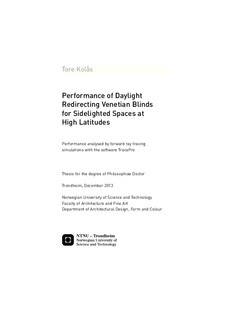| dc.description.abstract | The main topic of this thesis is daylight in buildings. More specifically, the thesis presents studies on the performance characteristics of venetian blinds used on the interior side of vertical windows. A particular emphasis is put on the daylighting properties of different blind types, and the performance of daylight redirecting blinds is compared to the performance of traditional white blinds.
Three factors are highly important for daylight in buildings: the daylight source, the optical properties of the fenestration or daylighting system, and the characteristics of the architectural space that receives the daylight.
Earlier works on daylighting systems in buildings have often documented the daylight levels and the daylight distribution within the space. With that approach it can be hard to pinpoint exactly why one daylighting system performs differently from another.
For the work presented here it has been a goal to focus on the properties of the fenestration system itself, while operating under various daylight conditions that are relevant for high latitudes. Some assumptions have been made regarding the architectural space (sidelighted with an elevated daylight opening), but apart from this it has been sought to describe the system performance more or less independently from the architectural space.
This approach can be compared to the approach that has been used in the field of electric lighting. There, luminaries are typically specified by performance characteristics that are not depending on the space in which they are to be applied. For electric luminaries, photometric properties such as luminous flux, light distribution and light output ratio are commonly used to describe the performance of the luminaire, and these values are independent of the space where the luminaire is to be used.
In other words, in this thesis, the venetian blind system is treated more or less as a “daylight luminaire”.
The main tool applied to analyse the photometric properties of the “daylight luminaire” is Monte Carlo forward ray tracing. The software TracePro is used extensively for this purpose. This software tool is tailor-made for analysing optical systems (including luminaries).
Unfortunately, daylight sources are not available in TracePro. For this reason, a substantial effort was made in order to generate TracePro light sources that represent the light from ground, sky and sun. However, once these sources were established and validated, many positive features of the program could be utilised with good effect in order to quantify a variety of different photometric characteristics (e.g. transmittance, light distribution and luminance) of venetian blind systems.
In order to analyse these characteristics in a systematic manner the fundamental geometrical properties of venetian blinds need to be understood and these properties have therefore been derived and described.
A new evaluation method for daylight redirection systems is presented in this thesis. This method is based on quantification of performance metrics already applied for such systems combined with new performance indicators suggested on the basis of literature findings as well as own studies of venetian blind performance.
The main goal of the new method is to provide a tool that can be used to indicate performance of a particular system with respect to 8 different important criteria that are determined by the properties of the daylighting system: (1) supply of daylight, (2) room darkening, (3) light distribution, (4) glare protection, (5) outward view, (6) privacy protection, (7) solar heat supply, and (8) overheating protection.
Star diagrams are used to provide a graphical illustration of the performance of the systems, where each of the 8 star points represents one of the 8 performance criteria used to evaluate the system.
The new evaluation method has been applied in order to compare the performance of traditional white blinds with that of daylight redirecting blinds. The results show that, when both blinds are operated in the semi-closed position, the performance is roughly the same for all of the performance criteria considered. However, when both blind types are operated in the open blind position, the daylight redirecting blind can perform better with respect to daylight supply and light distribution. The results presented in this thesis also show that these benefits can be obtained without worsening the performance with respect to the other criteria.
The performance of blinds has been studied for daylight conditions that are representative for high latitudes. It has sometimes been argued that, due to the typical low sun conditions, especially during the winter months, daylight redirecting blinds are less suitable at high latitudes. However, results presented in this thesis show that daylight redirecting blinds can function very well under most sun conditions that are typical for high latitudes, provided that the spacing to width ratio is carefully selected. | nb_NO |
